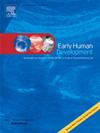Nasal DUOPAP vs nasal continuous positive airway pressure in preterm neonates with respiratory distress syndrome - A randomized control trial
IF 2
3区 医学
Q2 OBSTETRICS & GYNECOLOGY
引用次数: 0
Abstract
Background
There has been major shift in choice of respiratory support in preterm babies from invasive to non-invasive. There are various modes of non-invasive respiratory support. The comparative efficacy of one mode over another is an important research area.
Objective
To evaluate effectiveness of Nasal duo positive airway pressure (NDUOPAP) vs nasal continuous positive airway pressure (NCPAP) in reducing need of mechanical ventilation in preterms ≤35 weeks of gestation with respiratory distress syndrome.
Design
Open label, non-inferiority Randomized controlled trial.
Subjects
122 Neonates with GA ≤ 35 weeks (61 in NDUOPAP and 61 in NCPAP) with RDS & Silverman Andersen score ≥ 4, admitted to NICU.
Primary outcome.
Failure of allocated modes within first 120 h after birth.
Results
There was no significant difference between NDUOPAP: 11(18 %) and NCPAP:12(19.7 %) in treatment failure at the first 120 h of birth (p = 0.817). The morbidities including Patent Ductus Arteriosus, Pneumothorax, Intraventricular Hemorrhage, Sepsis, Necrotizing Enterocoilitis, Apnea of prematurity, Bronchopulmonary Dysplasia, Retinopathy of prematurity & mortality were similar between the two groups. The duration of non-invasive respiratory support, mechanical ventilation, oxygen therapy were also not significantly different. However the need for surfactant was lower in the NDUOPAP group when compared to NCPAP (p = 0.018).
Conclusions
NDUOPAP compared to NCPAP did not reduce the need for mechanical ventilation during the first 120 h of birth in preterms with RDS.
鼻DUOPAP与鼻持续气道正压治疗呼吸窘迫综合征的早产儿的随机对照试验
背景:早产儿呼吸支持的选择已经从侵入性转向非侵入性。无创呼吸支持有多种模式。一种模式相对于另一种模式的比较功效是一个重要的研究领域。目的评价鼻双气道正压通气(NDUOPAP)与鼻持续气道正压通气(NCPAP)对妊娠≤35周呼吸窘迫综合征早产儿减少机械通气需求的效果。设计:非劣效性随机对照试验。受试者:122例GA≤35周的新生儿(NDUOPAP 61例,NCPAP 61例)伴RDS;Silverman Andersen评分≥4分,入住NICU。主要的结果。出生后最初120小时内分配模式失效。结果NDUOPAP: 11例(18%)与NCPAP:12例(19.7%)在新生儿出生后120 h的治疗失败率差异无统计学意义(p = 0.817)。主要发病有动脉导管未闭、气胸、脑室内出血、脓毒症、坏死性小肠结肠炎、早产儿呼吸暂停、支气管肺发育不良、早产儿视网膜病变等;两组的死亡率相似。无创呼吸支持、机械通气、氧疗持续时间差异无统计学意义。然而,与NCPAP相比,NDUOPAP组对表面活性剂的需求较低(p = 0.018)。结论与NCPAP相比,snduopap并没有减少RDS早产儿出生后120 h机械通气的需求。
本文章由计算机程序翻译,如有差异,请以英文原文为准。
求助全文
约1分钟内获得全文
求助全文
来源期刊

Early human development
医学-妇产科学
CiteScore
4.40
自引率
4.00%
发文量
100
审稿时长
46 days
期刊介绍:
Established as an authoritative, highly cited voice on early human development, Early Human Development provides a unique opportunity for researchers and clinicians to bridge the communication gap between disciplines. Creating a forum for the productive exchange of ideas concerning early human growth and development, the journal publishes original research and clinical papers with particular emphasis on the continuum between fetal life and the perinatal period; aspects of postnatal growth influenced by early events; and the safeguarding of the quality of human survival.
The first comprehensive and interdisciplinary journal in this area of growing importance, Early Human Development offers pertinent contributions to the following subject areas:
Fetology; perinatology; pediatrics; growth and development; obstetrics; reproduction and fertility; epidemiology; behavioural sciences; nutrition and metabolism; teratology; neurology; brain biology; developmental psychology and screening.
 求助内容:
求助内容: 应助结果提醒方式:
应助结果提醒方式:


